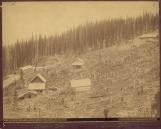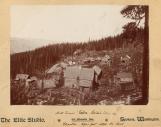1
Early development at the Silver King Mine
1890
Toad Mountain, near Nelson B.C

2
Silver King Mine site in Winter
1896
Toad Mountain, near Nelson B.C

3
The existence of precious metals in the West Kootenay had been realized long before the discovery of silver on Toad Mountain. The Indians were probably the first people to discover ore deposits in the area. Evidence also suggests that during the 1820's employees of the Hudson's Bay Company obtained lead, used for bullets, from the galena deposits on the eastern shore of Kootenay Lake. The Bluebell deposit was rediscovered several times before being worked commercially in the early 1880's. Between 1867-69 there was considerable placer mining on Forty Nine Creek. Using sluices and rockers the miners earned gold pay between $6-12 a day. However, it was the discovery of the copper-silver deposits on Toad Mountain in 1886 by the Hall Brothers of Colville, Washington that led to the development of the famous Silver King mine and promoted the settlement of Nelson.
4
Early buildings at the mine
1890
Silver King Mine, Toad Mountain, near Nelson B.C

5
Many of the early prospectors were American and American capital played a fundamental role in the development of the hard rock mines of the West Kootenay. An accumulation of capital in the United States, coupled with the proximity of British Columbia, encouraged a flow of money and companies during the early 1890's. The isolation of the area from Victoria and conservative nature of investors on Eastern Canada discouraged Canadian investment until the later 1890's. Although British capital became involved in the development of the Silver King, it was most significant after 1895.
6
Osner Hall, one of the party who discovered the Silver King Mine.
1890

7
American influence was felt in other ways. The difficulty of transportation routes in an east-west direction encouraged trading to develop between the West Kootenay and trading posts in Washington and Idaho. The CPR link-ups of the Columbia and Kootenay Steam Navigation Company were developed to protect Canadian interest, but the initial impetus for railroad and water routes came from American entrepreneurs.
8
Winslow Hall, one of the party who discovered the Silver King Mine.
1890

9
View of Nelson from the North Shore of the West Arm of Kootenay Lake
May, 1896
Nelson, B.C

10
Ore production from the Silver King mine was initially shipped to smelters in the United States. American politics were closely followed, particularly legislation influencing the price of silver and the introduction of lead ore tariffs. Indeed, the repeal of the Sherman Silver Purchase Act by the United States senate in 1893 determined the closure of many West Kootenay mines. Furthermore, the introduction of a 30 percent tariff on lead ores closed markets of the mines and was a factor in the development of local smelters in the Kootenay and Boundary regions during the mid-1890's.
11
General View of the Silver King Mine site.
1896
Toad Mountain, near Nelson B.C

12
Text by Helen Lee